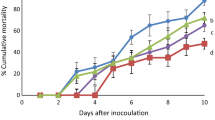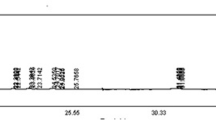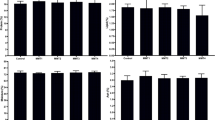Abstract
This study investigated the impact of the dietary supplementation of the water extract of algae Iyengaria stellata (IE) on the growth performance, fatty acid composition, antioxidant activity and disease resistance of shrimp Litopenaeus vannamei against Photobacterium damselae. A total number of 600 post larvae shrimp L. vannamei (mean 0.86 ± 0.01 g) were randomly divided into four groups (at three replications for each group). The control shrimp group (IE 0) was fed the basal diet free of supplemented IE. Other shrimp groups were fed the basal diet supplemented with IE at levels of 0.5 (IE 0.5), 1 (IE 1) and 1.5 (IE 1.5) g kg−1 diet. Upon the completion of eight weeks of feeding, the challenge test was carried out on 30 shrimps from each experimental group with SK7 strain of P. damselae. After 8 weeks of feeding trail, the shrimp taking IE1 at 1 and 1.5 levels showed a significantly better WG, SGR, PER, FW and PUFA compared to those fed IE 0 and IE 0.5 diets. Adding of IE I to experimental diet, led to significant difference (P < 0.05) in the antioxidant activity. Shrimp fed an IE 1 containing diet, showed the highest PO, CAT, SOD and GPX in comparison with other groups. In addition, incorporation of IE 1 supplemented diet at three doses, significantly reduced mortality percentage following challenging shrimp against P. damselae. The results indicate the positive effect of water extract from brown algae I. stellata at 1 g kg−1 dose, on growth, PUFA and antioxidant activity of L. vannamei and also, showed a remarkable decrease in mortality after challenge with P. damselae.

Similar content being viewed by others
References
Aguirre Guzman G, Sánchez-Martínez J, Cordova A, Luna A, Ascencio F (2009) Penaeid shrimp immune system. Thai J Vet Med 39:205–215
Akbary P, Aminikhoei Z (2018) Effect of polysaccharides extracts of algae Ulva rigida on growth, antioxidant, immune response and resistance of shrimp, Litopenaeus vannamei against Photobacterium damselae. Aquac Res 49:2503–2510. https://doi.org/10.1111/are.13710
Anaya-Rosas R, Rivas-Vega M, Miranda-Baeza A, Piña-Valdez P, Nieves-Soto M (2019) Effects of a co-culture of marine algae and shrimp (Litopenaeus vannamei) on the growth, survival and immune response of shrimp infected with Vibrio parahaemolyticus and white spot virus (WSSV). Fish Shellfish Immunol 87:136–143. https://doi.org/10.1016/j.fsi.2018.12.071
Austin B, Austin D (2007) Bacterial fish pathogens: Disease in farmeand wild fish. Springer, Netherlands
Banerjee K, Ghosh R, Homechaudhuri S, Mitra A (2009) Biochemical composition of marine macroalgae from gangetic delta at the apex of bay of Bengal. Afr J Appl Sci 1:96–104
Bradford MM (1976) A rapid and sensitive method for the quantitation of microgram quantities of protein utilizing the principle of protein-dye binding. Anal Biochem 72:248–254. https://doi.org/10.1016/0003-2697(76)90527-3
Campa-Córdova I, Hernández-Saavedra NY, Aguirre-Guzmán G, Ascencio F (2005) Immunomodulatory response of superoxide dismutase in juvenile American white shrimp (Litopenaeus vannamei) exposed to immunostimulants. Cienc Mar 31:661–669. https://doi.org/10.7773/cm.v31i4.32
Cano-Mallo M (2008) Bases biológicas de Ulva fasciata Delile, (Chlorophyta) para su posible explotación, al oeste de la Habana, Cuba (Tesis de Doctorado), Universidad de La Habana, Cuba, Recuperado de. http://www.oceandocs.org/bitstream/handle/1834/3404/Tesis?sequence=1
Chang C, Gao L, Cheng W (2013) Effect of dietary administration of hot-water extracts of Sargassum cristaefolium on the immunity of white shrimp Litopenaeus vannamei and its resistance against Vibrio alginolyticus. J Fish Soc Taiwan 40:27–41. https://doi.org/10.29822/JFST.201303_40(1).0003
Chanu T, Sharma A, Dam Roy S, Chaudhuri A, Biswas P (2012) Herbal biomedicine—an alternative to synthetic chemicals in aquaculture feed. J World Aquac 45:14–16
Cheng W, Liu CH, Kuo CM, Chen JC (2005) Dietary administration of sodium alginate enhances the immune ability of white shrimp Litopenaeus vannamei and its resistance against Vibrio alginolyticus. Fish Shellfish Immunol 18:1–12. https://doi.org/10.1016/j.fsi.2004.03.002
Choi YH, Lee BJ, Nam TJ (2015) Effect of dietary inclusion of Pyropia yezoensis extract on biochemical and immune responses of olive flounder Paralichthys olivaceus. Aquaculture 435:347–353. https://doi.org/10.1016/j.aquaculture.2014.10.010
Chotigeat W, Tongsupa S, Supamataya K, Phongdara A (2004) Effect of fucoidan on disease resistance of black tiger shrimp. Aquaculture 233:23–30. https://doi.org/10.1016/j.aquaculture.2003.09.025
Demirel Z, Yilmaz-Koz F, Karabay-Yavasoglu U, Ozdemir G, Sukatar A (2009) Antimicrobial and antioxidant activity of brown algae from the Aegean Sea. J Serb Chem Soc 74:619–628
Esquer-Miranda E, Nieves-Soto M, Rivas-Vega ME, Miranda-Baeza A, Piña-Valdez P (2016) Effects of methanolic macroalgae extracts from Caulerpa sertularioides and Ulva lactuca on Litopenaeus vannamei survival in the presence of Vibrio bacteria. Fish Shellfish Immunol 51:346–350. https://doi.org/10.1016/j.fsi.2016.02.028
FAO (2016) El Estado Mundial de la Pesca y la Acuicultura. Todas las solicitudes relativas a la traducción y los derechos de adaptación así como a la reventa y otros derechos de uso comercial deberán dirigirse a web. http://www.fao.org/contact-us/licence-request o a copyright@fao.org. Accessed 26 June 2016
Farahani F, Permeh P, Nasiri S, Gohari Kakhaki AR, Mohamad Gharachik B, Sohrabipoor J (2014) Biological properties of Brown algae in Northern Coast of Persian Gulf. Zanko J Med Sci 15:59–65
Fouz B, Toranzo AE, Biosca EG, Mazoy R, Amaro C (1994) Role of iron in the pathogenicity of Vibrio damsela for fish and mammals. FEMS Microbiol Lett 121:181–188. https://doi.org/10.1111/j.1574-6968.1994.tb07097.x
Gutiérrez-Leyva R (2006) Uso de harinas de Macrocystis pyrifera y Sargassum sp. en alimentos balanceados para camarón Litopenaeus vannamei: efectos sobre el crecimiento y la digestibilidad in vivo. Dissertation, Centro de Investigaciones Biológicas del Noroeste, La Paz, B.C., México
Hafezieh M, Ajdari D, Ajdehakosh Por A, Hosseini SH (2014) Using Oman Sea Sargassum illicifolium meal for feeding white leg shrimp Litopenaeus vannamei. Iran Fish Res Sci 13:73–80
Harikrishnan R, Kim J-S, Kim M-C, Balasundaram C, Heo M-S (2011) Styrax japonica supplementation diet enhances the innate immune response in Epinephelus bruneus against bacterial and protozoan infections. Exp Parasitol 129:260–265. https://doi.org/10.1016/j.exppara.2011.07.017
Huxley VAJ, Lipton AP (2010) Immunomodulatory effect of Sargassum wightii on Penaeus monodon (Fab.). Asian J Anim Sci 4:192–196
Ju ZY, Forster IP, Dominy WG (2009) Effects of supplementing two species of marine algae or their fractions to a formulated diet on growth, survival and composition of shrimp (Litopenaeus vannamei). Aquaculture 292:237–243. https://doi.org/10.1016/j.aquaculture.2009.04.040
Kumaran T, Citarasu T (2016) Isolation and characterization of vibrio species from shrimp and Artemia culture and evaluation of the potential virulence factor. Intellect Prop Rights 4:153–158. https://doi.org/10.4172/2375-4516.1000153
López A, Rico M, Rivero A, Suárez de Tangil M (2011) The effects of solvents on the phenolic contents and antioxidant activity of Stypocaulon scoparium algae extracts. Food Chem 125:1104–1109. https://doi.org/10.1016/j.foodchem.2010.09.101
Mohammadi E, Shabanpour B, Kordjazi M (2016) Evaluation of antioxidant and antibacterial activity of brown seaweed Iyengaria stellata collected from Persian Gulf. Aquat Physiol Biotechnol 4:44–57
Murphy C, Hotchkiss S, Worthington J, McKeown S (2014) The potential of seaweed as a source of drugs for use in cancer chemotherapy. J Appl Phycol. https://doi.org/10.1007/s10811-014-0245-2
Pedersen K, Skall HF, Lassen-Nielsen AM, Bjerrum L, Olesen NJ (2009) Photobacterium damselae subsp. damselae, an emerging pathogen in Danish rainbow trout, Oncorhynchus mykiss (Walbaum), mariculture. J Fish Dis 32:465–472. https://doi.org/10.1111/j.1365-2761.2009.01041.x
Peña-Rodríguez A et al (2010) Uso de Ulva clathrata en la nutrición del camarón blanco: revisión. Avances en nutrición acuícola. Memorias del X Simposio Internacional de Nutrición Acuícola. Universidad Autónoma de Nuevo León, San Nicolás de los Garza, 8–10 Noviembre 2010, Monterrey, pp 700–712
Raja R, Hemaiswarya S, Arunkumar K, Carvalho IS (2016) Antioxidant activity and lipid profile of three seaweeds of Faro, Portugal. Brazil J Bot 39:9–17. https://doi.org/10.1007/s40415-015-0200-8
Rendón L, Balcázar JL (2003) Inmunología de camarones: conceptos básicos y recientes avances. Aquatic 19:27–33. http://www.revistaaquatic.com/aquatic/art.asp?t=p&c=158
Reverter M, Bontemps N, Lecchini D, Banaigs B, Sasal P (2014) Use of plant extracts in fish aquaculture as an alternative to chemotherapy: current status and future perspectives. Aquaculture 433:50–61. https://doi.org/10.1016/j.aquaculture.2014.05.048
Rivas A, Lemos M, Osorio C (2013) Photobacterium damselae subsp. damselae, a bacterium pathogenic for marine animals and humans Front Microbiol 4:1-6. https://doi.org/10.3389/fmicb.2013.00283
Sahul Hameed AS, Rahaman KH, Alagan A, Yoganandhan K (2003) Antibiotic resistance in bacteria isolated from hatchery-reared larvae and post-larvae of Macrobrachium rosenbergii. Aquaculture 217:39–48. https://doi.org/10.1016/S0044-8486(02)00298-3
Schleder DD et al (2020) Impact of combinations of brown seaweeds on shrimp gut microbiota and response to thermal shock and white spot disease. Aquaculture 519:734779. https://doi.org/10.1016/j.aquaculture.2019.734779
Souza BWS et al (2012) Chemical characterization and antioxidant activity of sulfated polysaccharide from the red seaweed Gracilaria birdiae. Food Hydrocoll 27:287–292. https://doi.org/10.1016/j.foodhyd.2011.10.005
Stentiford GD et al (2012) Disease will limit future food supply from the global crustacean fishery and aquaculture sectors. J Invertebr Pathol 110:141–157. https://doi.org/10.1016/j.jip.2012.03.013
Sudaryono A, Haditomo A, Isnansetyo A (2015) Evaluation of dietary supplementation of aqueous extract of brown algae Sargassum cristaefolium on growth performance and feed utilization of juvenile white shrimp Litopenaeus vannamei. AACL Bioflux 8:142–149
Thanigaivel S, Chandrasekaran N, Mukherjee A, John T (2016) Seaweeds as an alternative therapeutic source for aquatic disease management. Aquaculture 464:529–536. https://doi.org/10.1016/j.aquaculture.2016.08.001
Traifalgar R et al (2009) Evaluation of dietary fucoidan supplementation effects on growth performance and vibriosis resistance of Penaeus monodon postlarvae. Aquac Sci 57:167–174
Vaseeharan B, Sundararaj S, Murugan T (2007) Photobacterium damselae ssp. damselae associated with diseased black tiger shrimp Penaeus monodon Fabricius in India. Lett Appl Microbiol 45:82–86. https://doi.org/10.1111/j.1472-765X.2007.02139.x
Wang T, Jónsdóttir R, Ólafsdóttir G (2009) Total phenolic compounds, radical scavenging and metal chelation of extracts from Icelandic seaweeds. Food Chem 116:240–248. https://doi.org/10.1016/j.foodchem.2009.02.041
Wijesekara I, Pangestuti R, Kim S-K (2011) Biological activities and potential health benefits of sulfated polysaccharides derived from marine algae. Carbohydr Polym 84:14–21. https://doi.org/10.1016/j.carbpol.2010.10.062
Yeh ST, Chen JC (2008) Immunomodulation by carrageenans in the white shrimp Litopenaeus vannamei and its resistance against Vibrio alginolyticus. Aquaculture 276:22–28. https://doi.org/10.1016/j.aquaculture.2008.01.034
Acknowledgements
Our special thanks go to each personnel in the Iranian Fisheries Science Research Institute (IFSRI), and Offshore Research Center, Chabahar, Iran for the worthwhile assistance provided by them.
Funding
No funding was received.
Author information
Authors and Affiliations
Corresponding author
Rights and permissions
About this article
Cite this article
Akbary, P., Gholamhosseini, A., Ali, M. et al. Growth Yield, Fatty Acid Profile and Antioxidant Status of Litopenaeus vannamei Fed Iyengaria stellata Supplemented Diet. Iran J Sci Technol Trans Sci 45, 111–119 (2021). https://doi.org/10.1007/s40995-020-01004-0
Received:
Accepted:
Published:
Issue Date:
DOI: https://doi.org/10.1007/s40995-020-01004-0




